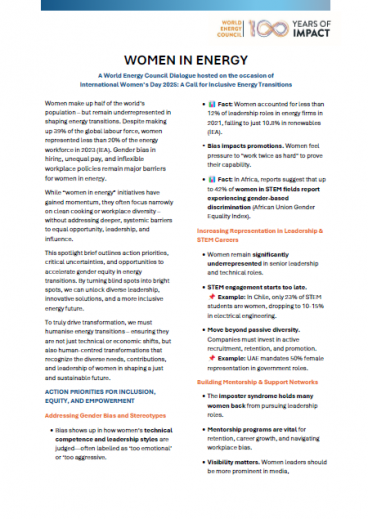World Energy Congress, Daegu, Korea, 15 October 2013: The World Energy Council (WEC) and Bloomberg New Energy Finance (BNEF) today launched a new landmark report into the worldwide cost of developing and delivering electricity.
The study, “World Energy Perspective: Cost of Energy Technologies”, provides a comprehensive comparative study of the costs of producing electricity from a range of conventional and unconventional sources. These include utility-scale wind, solar PV, solar thermal, marine, biomass, hydro, thermal, coal, gas, and nuclear.
The study assesses the front-end investment costs, operating expenditure, capacity factor and levelised cost of electricity (LCOE), a core industry measure, in the context of the global energy production landscape. The results do not represent the total cost of electricity supply such as grid connection, balancing costs for renewables, and back-up power capacity.
The LCOE analysis shows that there is a wide cost spectrum across the renewable energy technologies. The more mature clean energy technologies, such as hydro and onshore wind, fall close to parity with traditional sources when sited in a good location, while more emerging technologies such as marine tidal and wave are still at the early phases of cost discovery. (See figure below.)
Globally, coal is still the king of electricity production, accounting for more than 1.8 terawatts of installed generation capacity. Electricity from fossil fuels makes up 65% of global power production. However, in 2012 net investment in renewable power capacity outpaced that of fossil fuel generation for the second year running. US$228 billion was committed for renewable technologies, versus US$148 billion for additional fossil fuel generation.
Launching the report at the World Energy Congress in Daegu, South Korea, Guy Turner, Chief Economist at Bloomberg New Energy Finance, said:
“Our study finds that although fossil fuels continue to dominate, renewable energy and the investment appetite for them are growing from strength to strength. With wider deployment, the price of renewables will fall, reducing the risk for investors, and we expect to see greater uptake over the years. This study is crucial to helping investors make more informed decisions.”
Dr Christoph Frei, Secretary General of the World Energy Council, commented:
“Providing cleaner, more secure, and wider access to energy is a priority of every country. While the price of renewable energy remains high compared with fossil fuels in most contexts, the cost of most technologies, and most dramatically that of solar PV, is coming down with production scale-up in many areas of the world.
“Our recently published World Energy Scenarios report sees a continued strong global growth for renewable energy and for solar PV in particular over the next decades. With such growth, grid parity will become reality in the coming years. However, given the relatively high cost of storage and the need for backup power, it will be of paramount importance for countries to maintain a diversified energy mix and to overcome infrastructure bottlenecks.”
Generation output from renewable technologies was 23% of global capacity in 2010 and the WEC/BNEF study expects this portion to grow to 34% by 2030. Clean energy investment grew seven-fold between 2004 and 2011, with wind and solar continuing to dominate. Wind is expected to rise from 5% of installed capacity to 17% in 2030, and solar PV from 2% to 16% in 2030, with the relative contribution of fossil fuel falling from 67% in 2012 to 40-45% in 2030 (though capacity will grow in absolute terms).
Gas will continue to increase its share of the global electricity mix, particularly in North America, but persistent high relative costs of LNG will constrain its growth as a mainstream power source in Europe, the Middle East and Asia. The study anticipates that the contribution of nuclear energy will remain steady at around 6%.
In order for renewables to claim a greater share of the global mix, however, LCOEs, which are currently wide ranging around the world, must be controlled.
BNEF’s existing analytical framework shows that the costs of more mature clean energy technologies, such as hydro and onshore wind, are roughly equal to those of traditional sources, when sited in good locations and within more established investment landscapes. Emerging technologies, such as marine, tidal and wave, are still at the early stages of cost recovery.
However, the costs of producing electricity from a given technology tend to fall at a rate related to the level of usage. LCOEs for PV and onshore wind, for example, have fallen dramatically as governments have underpinned development through financial support. This support has encouraged rapid deployment, causing the cost of manufacturing to come down, while increasing the efficiency of production.
Key to aligning costs of production from clean energy with those of more traditional sources will be the resolution of wide ranging cost variations across regions, in order to form a broader, more stable basis for global investment and development.





_-80_result_688_387_s_c1_c_c.jpg)


